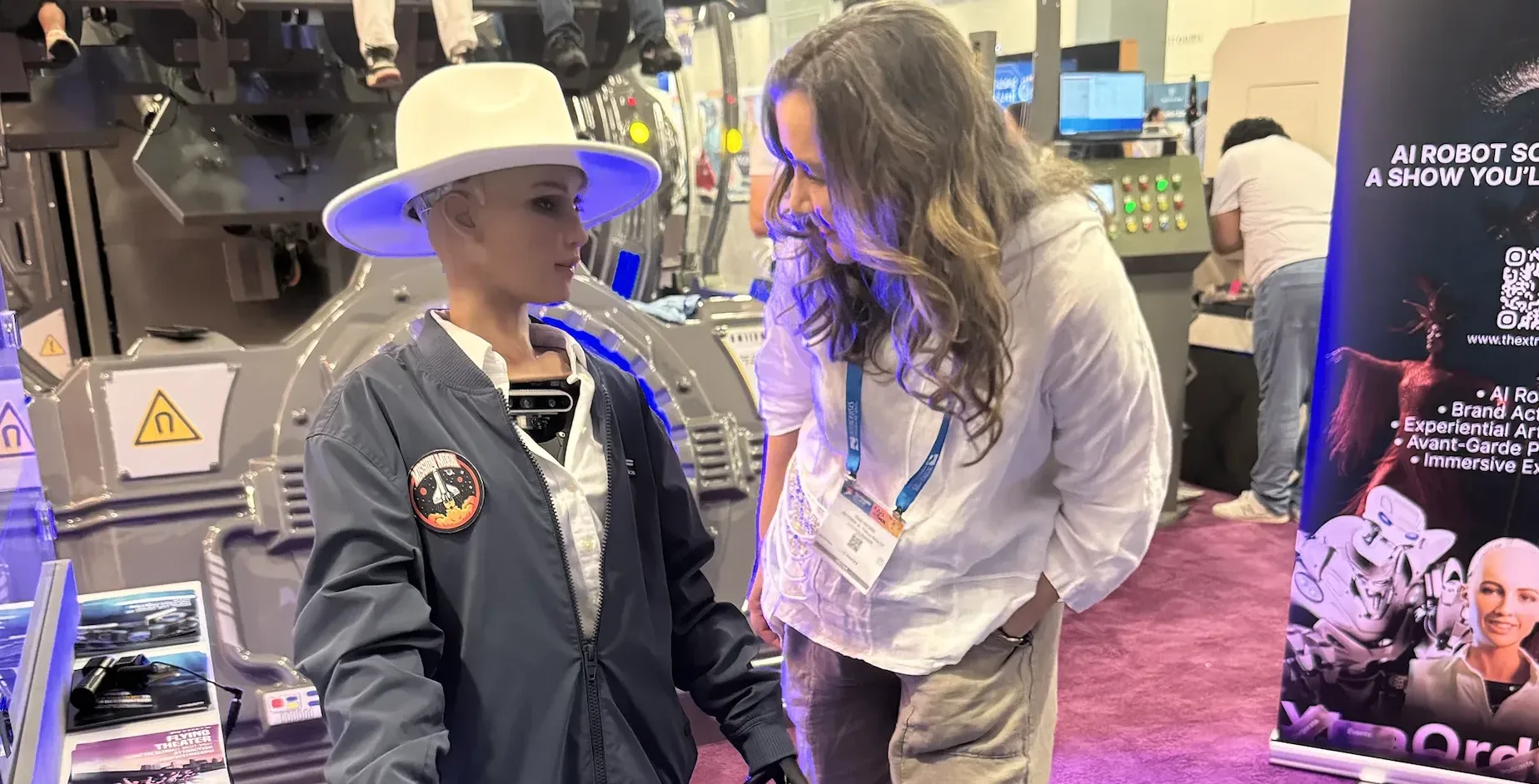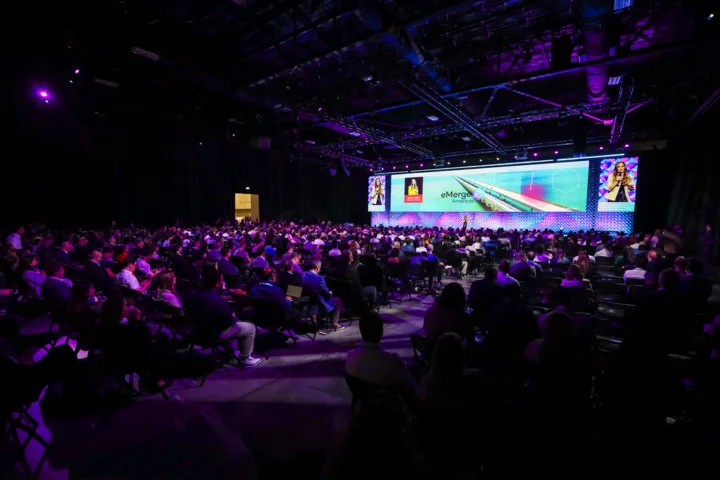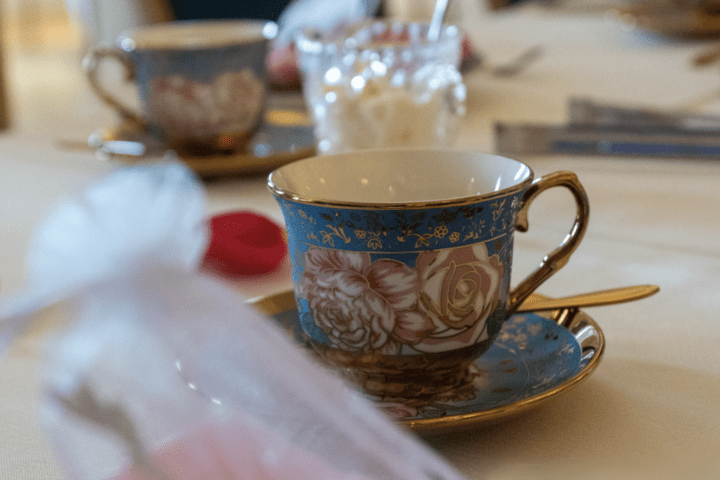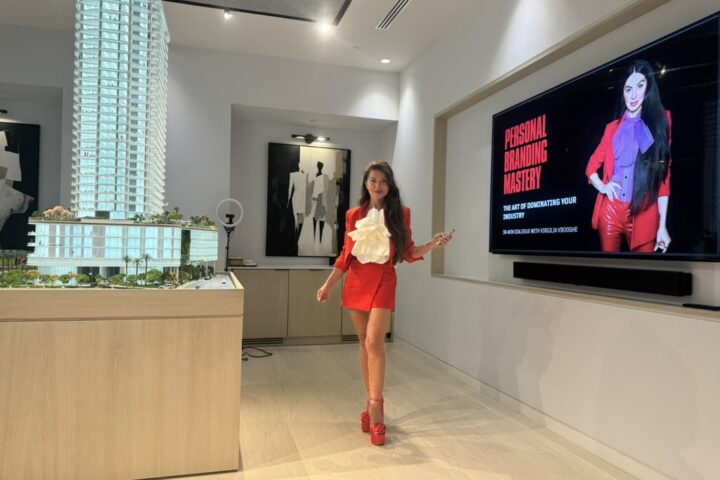By Zeynep A. Talu-Balci
There’s something poetic about stepping into the Miami Beach Convention Center during Seatrade Cruise Global. The hum of conversation, the swirl of branding, and the steady rhythm of footsteps from cruise professionals around the globe feel less like a trade show and more like a floating city anchored ashore, if only for a few days.
✿ Thank you for reading!
Subscribe to be our bestie, no spam—just good vibes once a month.
This year marked the 40th anniversary of Seatrade Cruise Global, the cruise industry’s premier gathering. I had the pleasure of attending with a press pass for she.work, which gave me the opportunity to experience the event not just as a spectator, but as a storyteller. Thousands gathered in Miami to reimagine everything, from onboard retail and sustainable sourcing to AI-powered logistics and destination immersion.
While the F&B@Sea activations and ribbon-cutting celebrations sparkled, a few sessions stood out as true compass points for where the industry is heading: inward, outward, and forward.
In this piece, I share highlights from some of my personal favorite sessions, along with a heartfelt nod to the exhibitors who proudly represented Türkiye on the global stage.
Retail Therapy at Sea: Reinventing the Cruise Shopping Experience
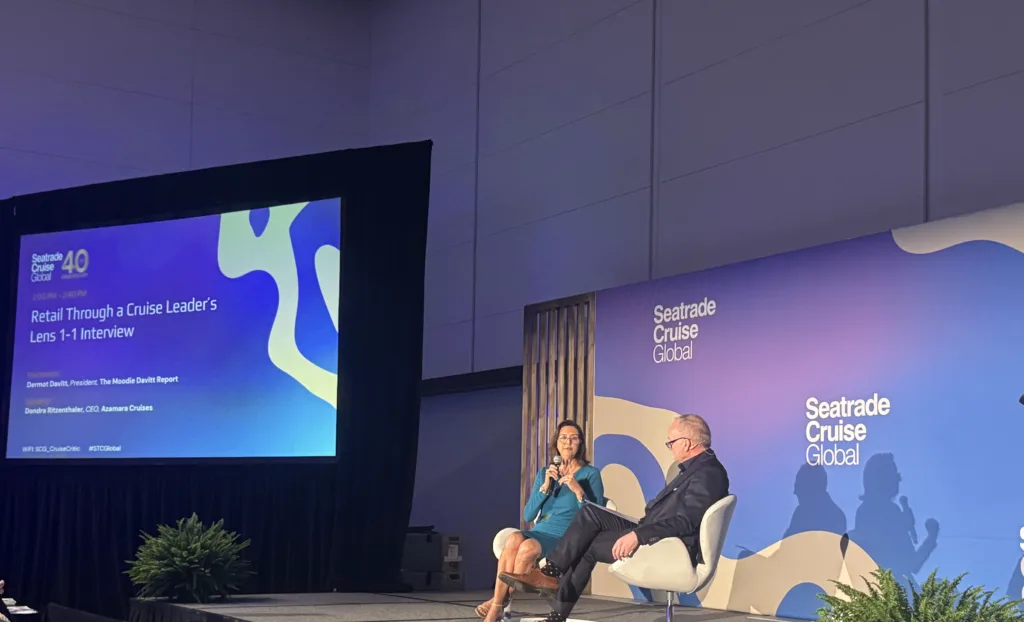
Who doesn’t love a little retail therapy – especially when it’s surrounded by ocean views and warm breezes?
At Seatrade Cruise Global 2025, one panel set out to answer a deceptively simple question: what do modern cruisers really want to buy at sea? The answers, sprinkled with humor, insight, and just a touch of retail soul-searching, came from industry leaders who are rethinking cruise retail from the deck up.
Moderated with wit and ease by Dermot Davitt of The Moodie Davitt Report, the Cruise Retail Strategy Panel unfolded like a conversation between longtime collaborators – each speaker bringing a different lens to the evolving world of onboard commerce.
Azamara CEO Dondra Ritzenthaler, who kicked off the Cruise Retail Strategy Panel with a self-deprecating admission (“Retail’s the piece I spent the least time with in my 40 years of business”), quickly demonstrated she had done her homework. “We can’t just put generic items for sale on our ships,” she explained. “When we’re in Greece, there needs to be things synonymous with Greek culture… it becomes much more authentic and special.”
Azamara’s strategy, she emphasized, is destination immersion, and that applies to their retail curation just as much as their itineraries. “We bring onboard people like this amazing woman in South Africa who makes sustainable bags and baskets, Mia Melange. Not only did she show our guests how she makes them, she sold out,” Ritzenthaler shared, her voice rising in excitement. “That to me is the magic… versus buying a polo you could get at Macy’s.”
Harding+ CEO Chris Matthews and Starboard Group’s Lisa Bauer echoed the move toward personalization and storytelling. “It’s all about personalization,” Bauer said. “My team jokes that if you made a drinking game out of how many times I say that word, you would be in trouble.” For Harding, data is king, Matthews added, but so is family. “We’re seeing a massive rise in family cruising,” he noted. “So we do mascots, we do Pandora parties, we make it fun.”
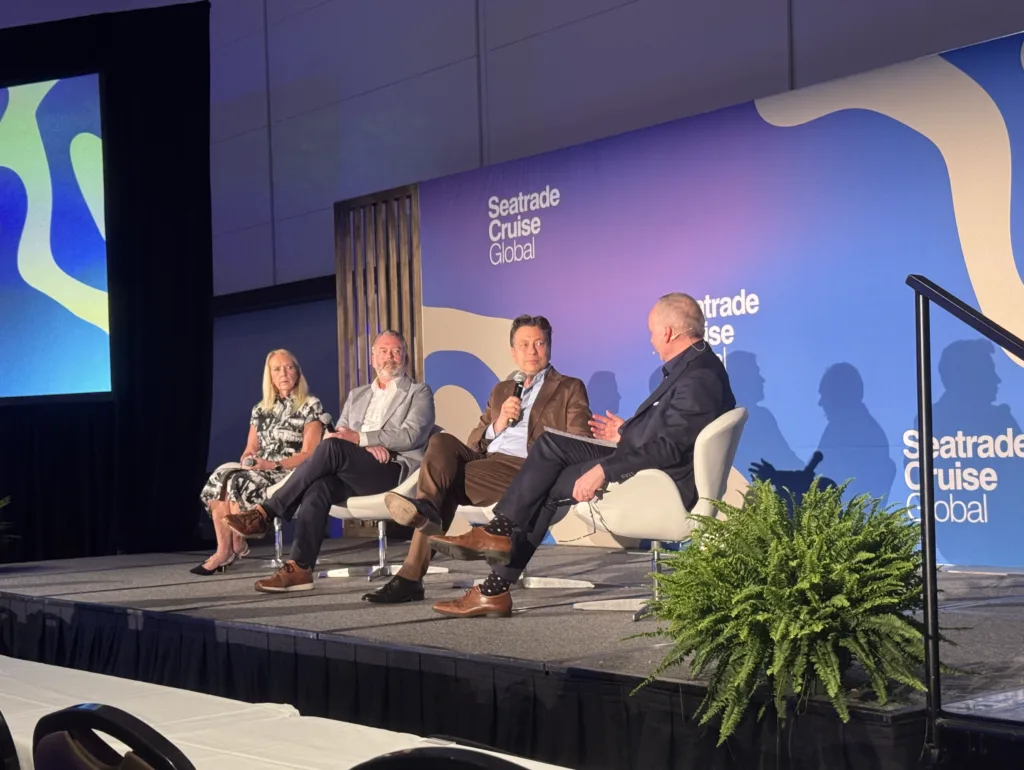
Personalization wasn’t just about products, it was about relationships. Matthews noted that cruise guests aren’t one-and-done shoppers: “They come into our shops three times a week, sometimes up to twelve times, so it’s not impulse buying, it’s experience building.”
MSC’s Stefano Meniotto, SVP of Onboard Revenue, brought in the data lens. “We’re leaning into exclusivity and scarcity,” he said. “Products that tell a story, something the guest can’t get anywhere else. It’s memory retail.” Meniotto also emphasized how different demographics, say, Americans cruising in Europe versus the Caribbean, spend very differently. The nuance, he said, is everything.
A common thread through it all? Sustainability. Resold Louis Vuitton. Responsible sourcing. Women-owned artisan brands. As Ritzenthaler put it: “People want to feel good when they splurge.”
And the takeaway for brands unsure whether to board the cruise ship of retail opportunity? “Every sign you look at shows how resilient cruising is,” Ritzenthaler said. “Hotels can’t move. We can.”
At its core, this panel wasn’t just about handbags or duty-free deals. It was about turning retail into an emotional memory, one that smells like local fruit, feels like handwoven silk, and just might outshine the spa. It’s about crafting stories people can carry home, long after the voyage ends.
When the Image Is Perfect – But Fake: AI in the Maritime Industry
If you wanted to feel the generational tremble of technological disruption at Seatrade Cruise Global, you found it in the AI in Maritime Industry Panel, titled with a wink: “AI Ready or Not, Here It Comes.”
Moderated by Anna Silva, Manager Cruise Operations, Manager HSE at Port Everglades Terminal LLC, the session delivered exactly what its name promised: not a tech deep-dive, but a very human conversation about how artificial intelligence is quietly, awkwardly, and sometimes brilliantly creeping into maritime workflows, from press releases to port communications, customer experiences to legal policy.
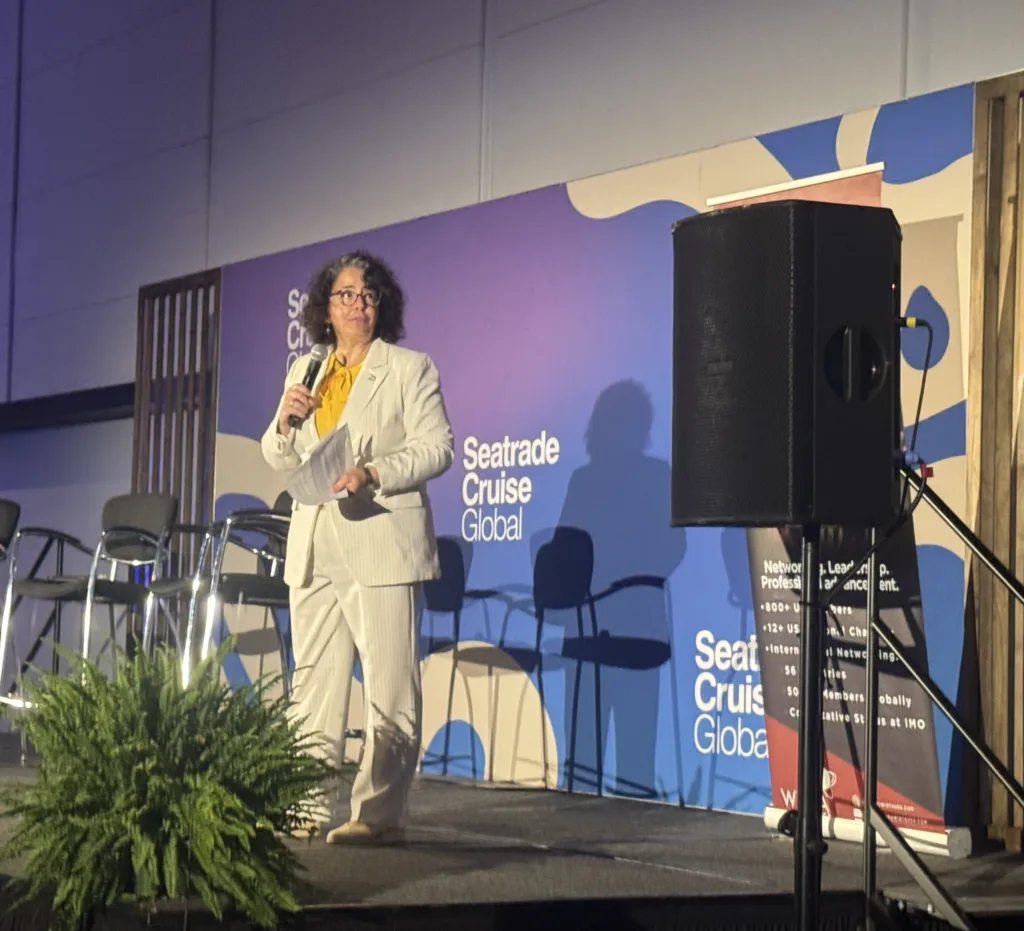
Port Everglades’ Public Information Officer Joy Oglesby described AI as a helpful assistant, one she approaches with “caution,” and never without a journalist’s instinct to double-check everything. “It kind of just gives me a brainstorm session,” she said, “like, ‘Oh, I wouldn’t have thought of it that way.’ But I still have to rewrite the release.”
But the panel’s most cinematic moment came from Carmen Morrison, Product Manager at National Geographic Day Tours. “We used AI to generate photos of new tours,” she explained. “Then we tested them in a consumer survey. About 70% of people couldn’t tell which images were AI and which were real.”
That might’ve sounded like a win, until she dropped the twist.
“As soon as we told them that some of the images were AI-generated, the reaction changed. They said, ‘If those pictures are AI, then you have the disclaimer that these are AI products, I will not buy the product because I do not trust that what I’m seeing is what I’m going to experience.”
So National Geographic made a decision: no AI-generated imagery for now. Real destinations, real visuals. “Trust is a major factor,” Oglesby agreed. “You don’t want to destroy that.”
And so, this was not a panel about dazzling use cases or breathless innovation. It was a panel about training employees. About hallucinations, AI-generated falsehoods so plausible they might win a lawsuit (until the court realizes the cited case law doesn’t exist). About company-wide policies. About subscription-based models that protect proprietary data, versus open ones that share it with the world. About the tension between speed and authenticity, automation and transparency.
And it was also about this: three sharp women, each navigating a future they didn’t exactly sign up for, but now must help shape. “AI is not here to replace your job,” Morrison said. “It’s here to help you do your job better. But only if you know how to use it.”
In the end, Silva confessed: “I’ve never had an ‘AI lunch.’ It’s never even been on my calendar. But after this panel, maybe it should be.”
Ultra-Luxury at Sea: The Ritz-Carlton and Orient Express Set Sail in Style
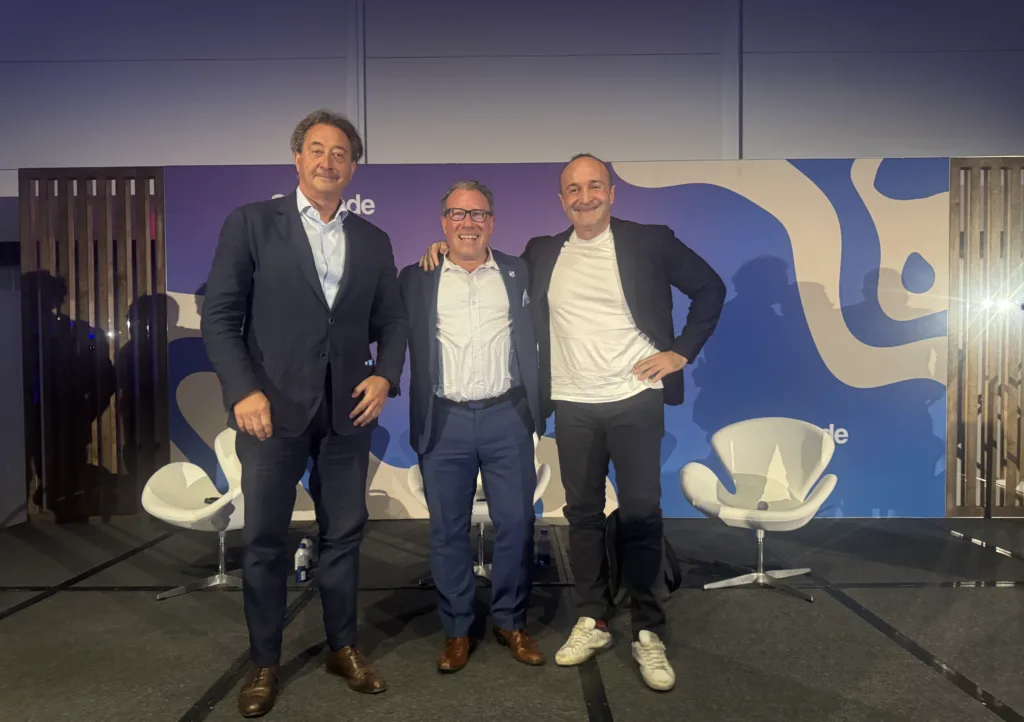
Perhaps the most soulful moment of the conference came during the Luxury Cruise Industry Panel moderated by Jason Gelineau, Principal of JAG Hospitality, featuring Ritz-Carlton Yacht Collection’s Ernesto Fara and Orient Express Silenseas’ Philippe Brault.
This wasn’t a session about ships. It was a masterclass in ethos.
Representing The Ritz-Carlton Yacht Collection, President Ernesto Farah set the tone with clarity: this is not about translating hotel luxury into a cruise format.
“The spa is a real spa. The restaurants are real restaurants,” he said. “They are not cruise versions of something… it’s something new.”
With guests onboard for seven to ten days, Farah sees the extended time as an opportunity for intimacy and adaptability.
“They’re with us most of the time, under our guidance, for all these moments,” he explained. “That gives us an incredible number of touchpoints.”
The result? An experience that evolves mid-voyage, shaped by what guests discover they want – not what they expected before they stepped onboard.
Ritz-Carlton’s Ilma and Luminara weren’t designed to “compete” with traditional cruise lines. They were created to reimagine the very reason we travel. With suites that feel like sanctuaries and scents that linger like a memory, their ships are less about being “at sea” and more about being fully present.
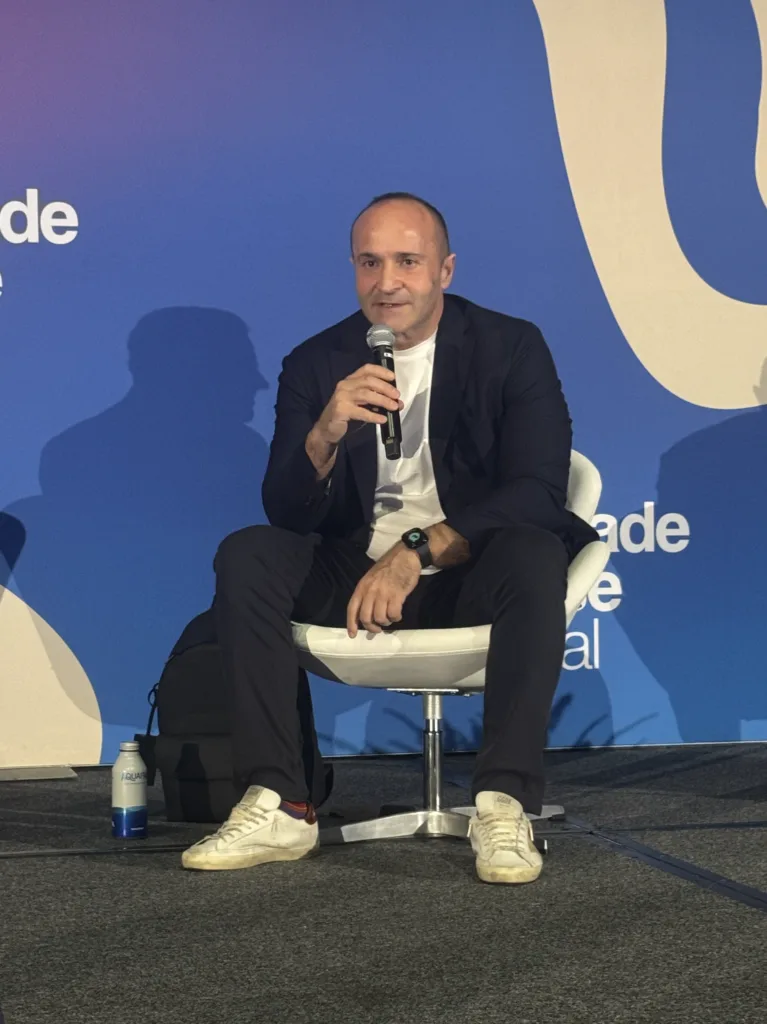
Personalization, he emphasized, is non-negotiable. “You have to be listening,” he said. “Adaptation is key.” And when it comes to brand power, Ritz-Carlton isn’t flying solo. With Marriott Bonvoy’s global loyalty platform and Ritz’s own creative team producing everything from videos to brand messaging, the storytelling remains deeply connected to the brand’s DNA.
“It’s not about things,” Fara said. “It’s about yourself, and in connection with someone else.”
Across the stage, Philippe Étienne, CEO of Orient Express Silenseas, brought a sense of heritage – and quiet confidence.
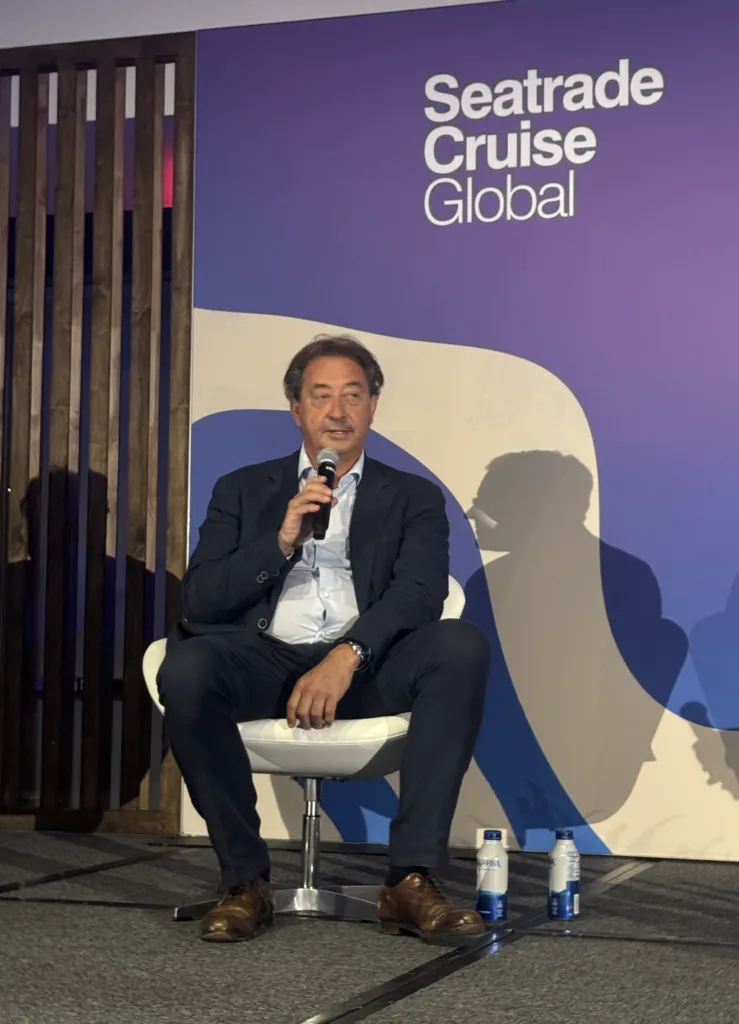
“We’re not trying to replicate a hotel at sea,” he said. “This is something between cruising and yachting.”
Backed by Accor and LVMH’s luxury lifestyle portfolio, Orient Express is building not just yachts, but a trilogy of experiences: hotels, trains, and ships.
“There will be itineraries between Paris, Venice, and Istanbul,” he shared. “A night in a Cheval Blanc Hotel, a journey on a train, and then sailing aboard our yacht.”
Design continuity across all three verticals is intentional – from signature bars shared with the train to cabins on Deck 7 inspired by the original Orient Express aesthetic. The details are where the magic lives.
“We have a 500-square-meter spa. Guerlain will be running it,” Étienne said. “We signed Yannick Alléno – he just earned his 17th Michelin star last week in Monaco. And our sommelier also curates the wine cellar for Air France’s Première class.”
What both brands made clear was this: their approach to cruising is not about scaling hospitality up, but carving it down – distilling it to its most intimate, immersive, and memorable form. No logos splashed across hulls. No copy-paste experiences. Just elegance, discretion, and the kind of luxury that doesn’t need to announce itself.
At its core, this panel wasn’t just about beautiful ships or Michelin stars. It was about crafting something singular – where a voyage doesn’t just take you to new destinations, but deeper into a brand’s soul. And maybe even your own.
Brunch, Mimosas, and the Soul of Innovation: Women Navigate AI at Seatrade
There were no waffles, but there were mimosas, and something even more nourishing: a candid, collective reckoning with the promise and pitfalls of artificial intelligence.
Hosted in partnership with WISTA (Women’s International Shipping & Trading Association) and supporting Mercy Ships, the sold-out Navigating AI in the Cruise Industry brunch invited a room full of cruise professionals to think bigger, and deeper, about the tools shaping their future.
Moderated by Anne Slova, Manager of Cruise Operations at Reflections Journal, the panel was refreshingly grounded. There were no breathless headlines or overhyped promises here. Just women in leadership, asking smart questions, sharing real stories, and honoring the trust their audiences place in them.
Joy Oglesby, Public Information Officer at Port Everglades, offered a down-to-earth perspective on using AI to draft press releases. “It gives me a new way to look at something,” she said, “but I always rewrite the release.” For Joy, AI isn’t a replacement. It’s a collaborator, useful but not infallible.
Carmen Morosan, Global Shore Excursions Product Manager at Intercruises, shared one of the most striking moments of the morning. Her team, working on behalf of National Geographic Day Tours, faced a familiar challenge: they had developed a new tour but didn’t yet have photography. So they turned to AI-generated images.
Then they tested the images with consumers in a controlled survey. “Can you tell which photos are AI and which are real?” they asked. About 70% of respondents couldn’t. But then came the twist.
“As soon as we told them that those images were AI,” Carmen explained, “they said, ‘If you put those pictures in your product without a disclaimer, I will not buy it. I don’t trust that what I’m seeing is what I’m going to experience.’”
The response was clear. The issue wasn’t the technology. It was the perception, the feeling of being misled.
So National Geographic made a values-driven decision: no AI-generated visuals in their marketing. The exercise became a lesson in consumer psychology and brand integrity. “It was an interesting experiment,” Carmen said. “We learned a lot about how people feel about trust.”
Rounding out the conversation, Christine Walker, Shareholder at Fowler White Burnett, addressed the legal and ethical terrain. Misinformation, privacy, hallucinated case law, it’s no longer about whether AI can do something. It’s about whether we should let it. And how to stay accountable when we do.
In the end, this wasn’t just a brunch about technology. It was a brunch about stewardship. About choosing transparency over speed, clarity over convenience, and leadership over automation.
The proceeds supported Mercy Ships, a nonprofit delivering free, life-changing surgeries in underserved countries, a perfect echo of the morning’s theme: that innovation, at its best, is in service of humanity.
And maybe that’s what made this panel so powerful. It reminded everyone that AI is not some distant force. It’s here. It’s learning. And it’s ours to shape, ethically, intentionally, and together.
The Future is Hydrogen: A Cruise Industry First
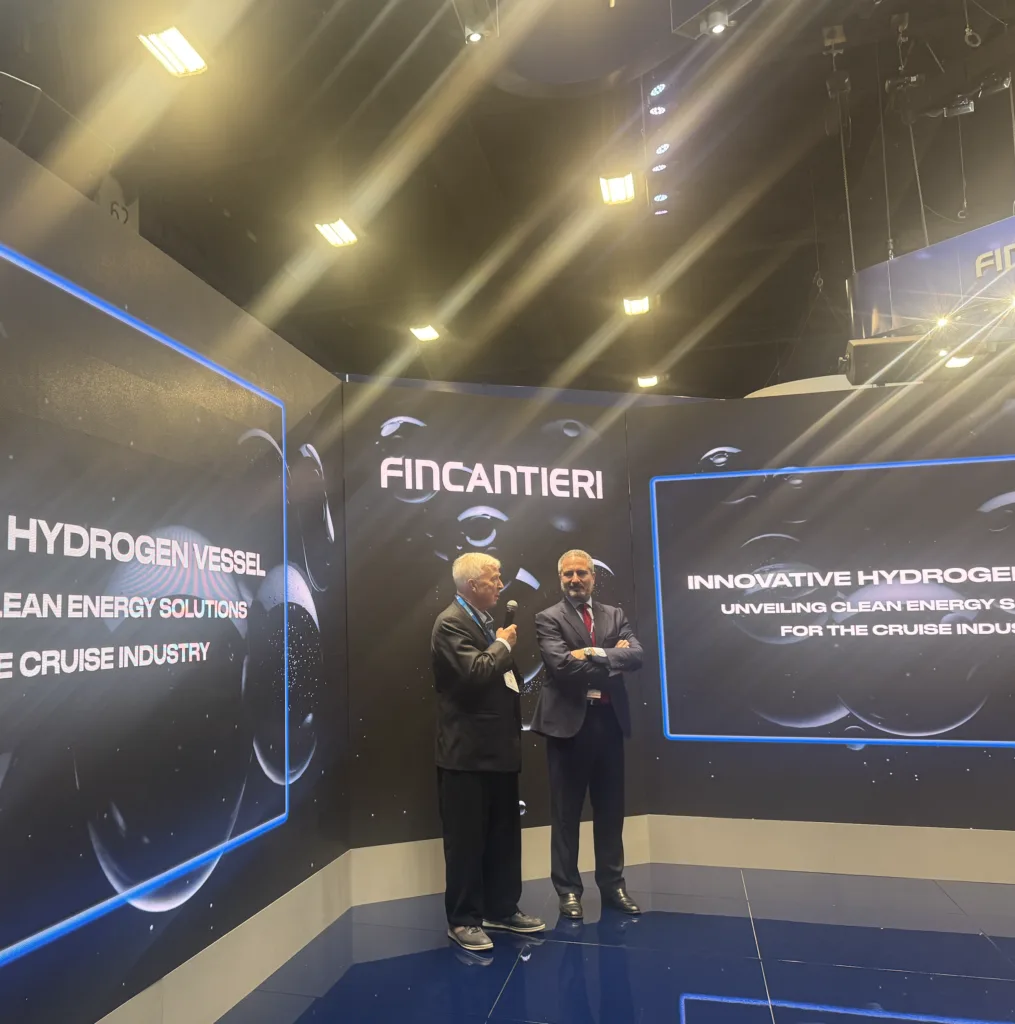
There are moments at industry conferences that shimmer with possibility, quiet, unassuming, and yet undeniably historic. The unveiling of the cruise industry’s first hydrogen-powered ship by Fincantieri and Viking was one of them.
In a gathering filled with spectacle and strategy, this presentation stood out for its restraint. There were no sweeping visuals or dramatized announcements, just Fincantieri CEO Roberto Fazioli and Viking Chairman Torstein Hagen, two titans of the industry, stepping forward not with a dream, but with something far more powerful: a working model.
What they revealed was not only a ship design, but a breakthrough in clean energy at sea: a modular fuel cell system powered by liquefied hydrogen, delivered in containerized units for scalability and flexibility. This elegant system solves two of the most pressing challenges in maritime decarbonization, storage and distribution, without waiting for the rest of the hydrogen economy to catch up.
For years, the industry has leaned on LNG (liquefied natural gas) as a cleaner alternative to traditional marine fuels. LNG reduces emissions but still produces carbon, and as Hagen put it gently, but unmistakably, “It’s not the way toward zero emissions.” Hydrogen, on the other hand, when used in fuel cells, produces only water vapor as a byproduct.
It was a statement not just of technological progress, but of philosophical clarity. “At some point,” Hagen said, “you have to place your bet. We’re placing ours.”
Fazioli called the shift the “marinization of hydrogen”, a poetic phrase that captures the immense challenge of adapting land-based clean energy systems to the demands of open water. But more than that, it signals something rare in the cruise sector: a move from possibility to proof.
As a sustainability advocate, it was deeply moving to witness this moment. Because amid all the talk of targets and timelines, this was action. It was leadership. It was an industry not waiting to be pushed, but choosing to pull.
“This idea is not just theoretical,” Fazioli said. “It’s industrialized. It’s commercial. It’s possible.”
And in that possibility lies a promise, not only to the future of cruising, but to the future of our planet.
A Ride Through Wonder: DOF Robotics and the Power of Curiosity

Some booths are about business cards. Others? Pure magic.
DOF Robotics didn’t just have one of the most visually exciting installations at Seatrade Cruise Global, it offered one of the most unexpectedly personal moments of the week for me.

I hadn’t realized the company was Turkish when I walked up to their booth. I was just following the pulse of excitement, and the sound of delighted screams, toward a motion simulator that promised an immersive journey through the Great Wall of China. What I didn’t expect was how real it would feel. The wind in your face, the rush of the turns, the visceral sense of climbing history’s most iconic fortification, only to plunge into a virtual valley moments later. It was pure adrenaline. And as it turns out, it was Turkish-engineered adrenaline.
But here’s where it became something more than spectacle: I had recently whispered a wish to The Universe. A quiet yearning to one day visit the Great Wall of China. And there I was – soaring over it, unexpectedly. A reminder that The Universe hears us. It’s just that sometimes, it answers with VR.
Behind this experience is a story of purpose. Mustafa Mertcan, the founder of DOF Robotics, first fell in love with amusement rides not as a thrill-seeker – but as a curious child. As a teenager visiting Tatilya, Türkiye’s famous theme park, he didn’t just enjoy the rides – he wanted to understand how they worked. That spark became his calling.
Since then, DOF Robotics has grown into one of the most respected names in immersive technology – over 500 projects across 60+ countries, seamlessly integrating storytelling, motion, and design to ignite wonder without motion sickness (a marvel in itself). Their mission goes far beyond entertainment. It’s about engineering emotion. Inviting people not just to watch, but to feel.
And then came the moment that moved me most: when I mentioned that a few of my friends hadn’t been able to attend the show, DOF Robotics gifted full Seatrade passes. It wasn’t just generous – it was deeply human. They turned an exclusive experience into a shared memory.
And as if the story needed a final flourish, Sophia, Hanson Robotics’ most advanced human-like robot Sophia – who holds Saudi citizenship, has appeared on The Tonight Show, and even possesses her own credit card – visited the DOF Robotics booth on the final day. A humanoid marvel stepping into a world built by storytellers of motion and imagination. It felt symbolic. And strangely intimate.
While many companies chase attention through noise or novelty, DOF Robotics did something quieter – and far more profound. They chose to connect. There was something deeply human in the way they welcomed guests, in the joy their rides sparked, and in the story of how it all began – with a young boy wandering through Tatilya, mesmerized by the mechanics behind the magic.
Their booth wasn’t just about tech. It was about feeling. About stepping into a ride through the Great Wall of China with wide eyes and an open heart – and, in my case, laughing quietly at The Universe’s humor.
This is what I carry with me from DOF: a reminder that the future doesn’t have to feel cold or complicated. It can be warm. It can be joyful. It can invite us back to that part of ourselves that still believes in wonder.
From Humble Beginnings to Global Sponsorship: A Turkish Story Worth Telling
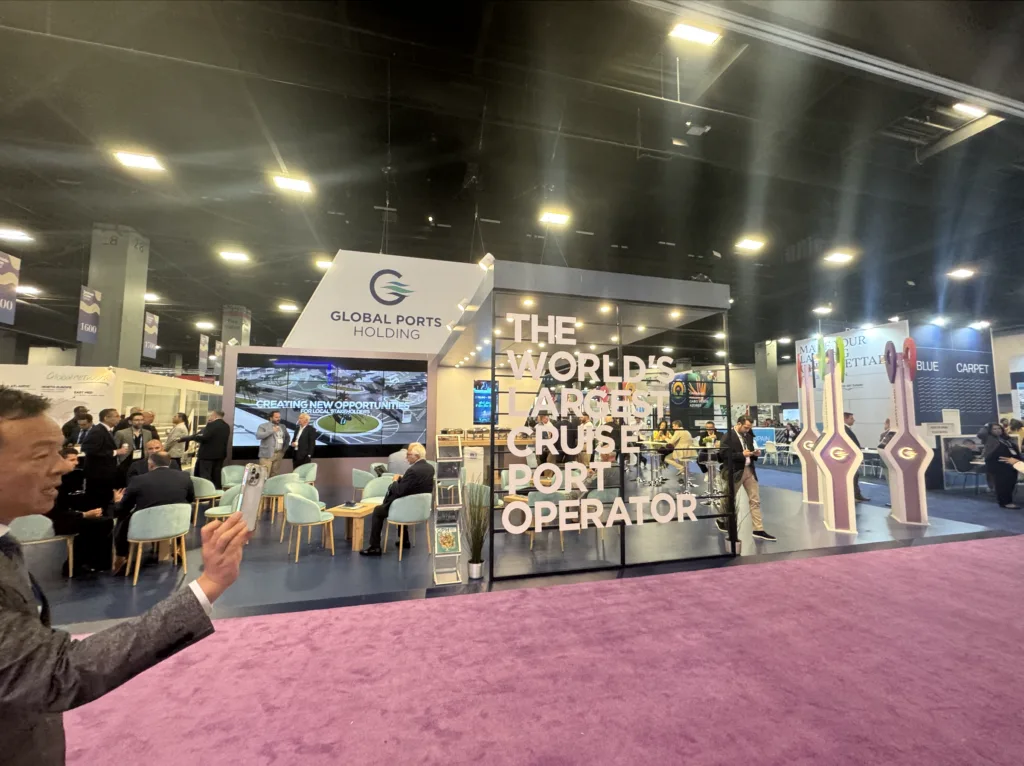
At Seatrade Cruise Global 2025, Global Ports Holding reminded us that scale matters – but so does vision. From the Med to the Caribbean, this is what leadership at sea looks like.
I met Erol Göker at the DOF Robotics booth, before I ever stepped onto their motion ride. We were both tucked into the corner of a space filled with laughter, motion simulators, and curious onlookers. What I expected was a conversation about tech and entertainment. What I received was a story of vision, humility, and perseverance.
About 3 decades ago, Göker and his team of financial analysts ran a study on the world’s fastest-growing industries and discovered the cruise sector was expanding at a remarkable 15% annually. That single data point became their north star. What began as a financial analysis turned into a lifelong commitment to an industry they believed in.
He spoke with a quiet humor that immediately put me at ease. There was no need for pretense. His words carried the calm assurance of someone who had built something extraordinary, not through bravado, but through patience and purpose. He shared how, decades ago, they could barely afford to attend Seatrade Cruise Global. And yet, they came – year after year – learning, listening, and watching.
This year, that belief came full circle. Not only was Global Ports Holding the largest cruise port operator in the world, but they were also the main sponsor of Seatrade Cruise Global. From not being able to buy tickets to becoming the event’s most prominent backer, it’s the kind of full-circle moment that speaks to the power of long-term vision and the courage to stay the course.
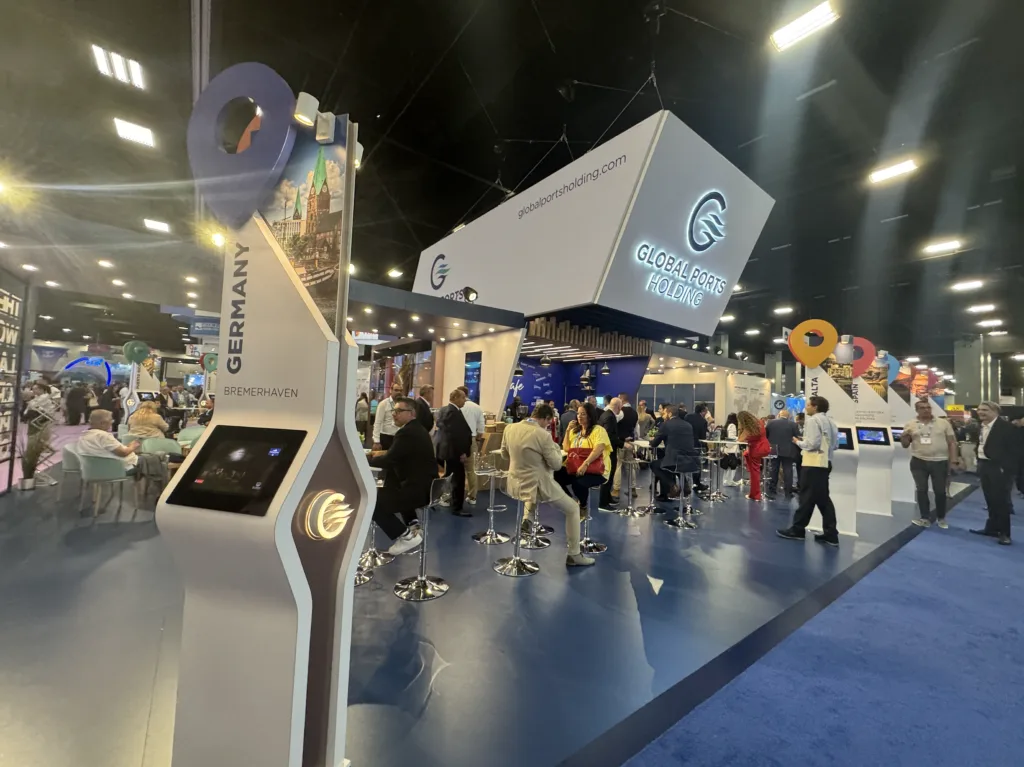
Their booth reflected the same values that built the company: substance over spectacle. There was always coffee brewing (logo and all), snacks shared freely, and a warmth that crossed cultures and industries. It reminded me of something we don’t often say in business: that being welcoming is also a form of leadership.
What struck me most wasn’t the scale of their operations. It was his tone. Humble. Wry. Kind. You wouldn’t guess he helped transform a Turkish finance firm into a global cruise infrastructure empire. Because he didn’t lead with ego. He led with insight. And story.
And isn’t that what great brands do?
Today, Global Ports Holding anchors nearly every major cruise itinerary. They’re investing in transformative infrastructure: from the €5.5 million self-sufficient terminal in Tarragona, to San Juan’s $42 million upgrades, to the new Prince Rupert Cruise Port, marking their expansion into North America. But more than building terminals, they’re telling the story of cities. Of place. Of welcome.
Still, this story is about more than ports.
It’s about how legacy is built. Not in quarters. But across decades. By people who believe in potential, of a market, of a moment, of a country.
As a Turkish woman standing in that booth, watching the world gather under a banner that read “Global Ports Holding – Main Sponsor”, I didn’t just feel proud.
I felt super proud.
Because when Turkish innovation is not only present, but leading, generously and gracefully, it sends a message to every curious kid walking through a trade show with dreams bigger than their badge access:
Start where you are. Think beyond what you can see.
That’s how ports get built.
That’s how leaders rise.
And that’s how stories, ours, yours, Türkiye’s, go global.
I hadn’t yet stepped on DOF’s ride through the Great Wall of China. But somehow, I was already transported, by this story, by this encounter, and by the feeling of pride that only comes when something deeply personal shows up powerfully on the world stage.
Why It Matters, for Women, for the World
As I listened to these industry leaders describe their journeys, I kept coming back to one thought: this is no longer about cruise as leisure. This is cruise as leadership.
Women are leading ships, shaping guest experiences, curating retail, and redefining hospitality from the inside out. Companies are integrating sustainability not just in operations, but in mindset, prioritizing local artisans, pre-loved luxury, and community-first sourcing.
And Turkish innovation has found a home on this global stage. Companies like Dof Robotics, pioneers in immersive entertainment, and Global Ports Holding, the world’s largest cruise port operator headquartered in Istanbul, were proof that Turkish talent is not just participating in this evolution. We are co-authoring it.
As I listened to these industry leaders describe their journeys, I kept coming back to one thought: this is no longer about cruise as leisure. This is cruise as leadership.
Women are leading ships, shaping guest experiences, curating retail, and redefining hospitality from the inside out. Companies are integrating sustainability not just in operations, but in mindset, prioritizing local artisans, pre-loved luxury, and community-first sourcing.
And Turkish innovation has found a home on this global stage. Companies like Dof Robotics, pioneers in immersive entertainment, and Global Ports Holding, the world’s largest cruise port operator headquartered in Istanbul, were proof that Turkish talent is not just participating in this evolution. We are co-authoring it.
A Final Reflection: Purpose as the New Compass
As I walked out of Seatrade Cruise Global and back into the rhythm of Miami, I carried more than a notebook full of insights. I carried stories. Stories of risk and reinvention, of technology tempered by trust, of Turkish innovation rising with grace. But most of all, I carried the reminder that even in the most technical of industries, what truly moves us is meaning.
Cruising is no longer just about where we go. It’s about why we go.
And the future? It belongs to those who design with soul.
If you’re building that future, whether through ports, platforms, or purpose, we would love to hear from you. Let’s keep telling stories that travel further than any ship ever could.
✱ If you liked this article, please share it with a friend who could use inspiration.
If you have a topic in mind or a story to share anonymously or with your name, email us at team@she.work

